The AMD A8-7650K APU Review, Also New Testing Methodology
by Ian Cutress on May 12, 2015 10:00 AM ESTProfessional Performance: Windows
Agisoft Photoscan – 2D to 3D Image Manipulation: link
Agisoft Photoscan creates 3D models from 2D images, a process which is very computationally expensive. The algorithm is split into four distinct phases, and different phases of the model reconstruction require either fast memory, fast IPC, more cores, or even OpenCL compute devices to hand. Agisoft supplied us with a special version of the software to script the process, where we take 50 images of a stately home and convert it into a medium quality model. This benchmark typically takes around 15-20 minutes on a high end PC on the CPU alone, with GPUs reducing the time.
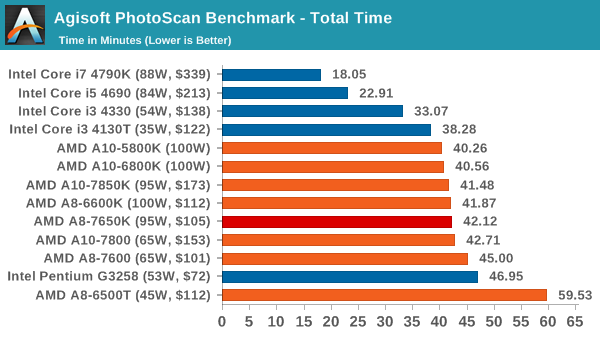
Photoscan prefers full threads and high IPC, so the low end i3, AMDs APUs and the G3258 all perform within a similar margin.
Cinebench R15
Cinebench is a benchmark based around Cinema 4D, and is fairly well known among enthusiasts for stressing the CPU for a provided workload. Results are given as a score, where higher is better.
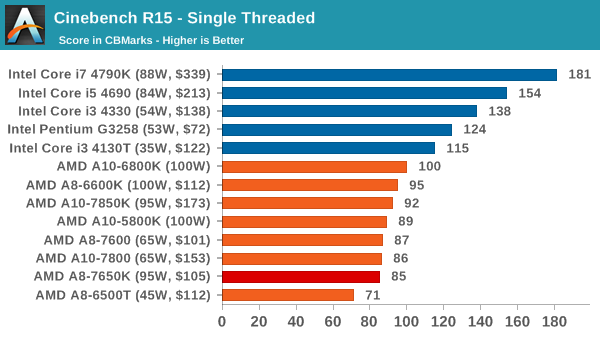
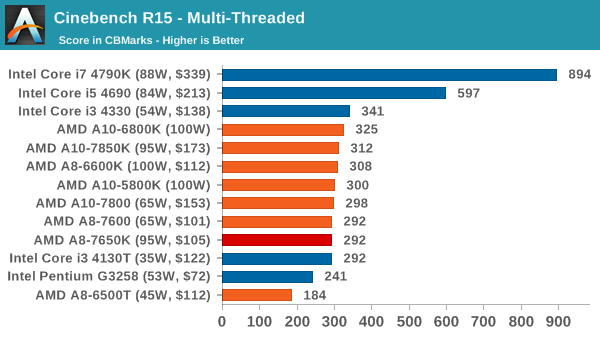
Despite the single thread performance, in multithreaded the gap between Pentium, i3-T, APU and i3 is similar to that seen in Photoscan.
HandBrake v0.9.9: link
For HandBrake, we take two videos (a 2h20 640x266 DVD rip and a 10min double UHD 3840x4320 animation short) and convert them to x264 format in an MP4 container. Results are given in terms of the frames per second processed, and HandBrake uses as many threads as possible.
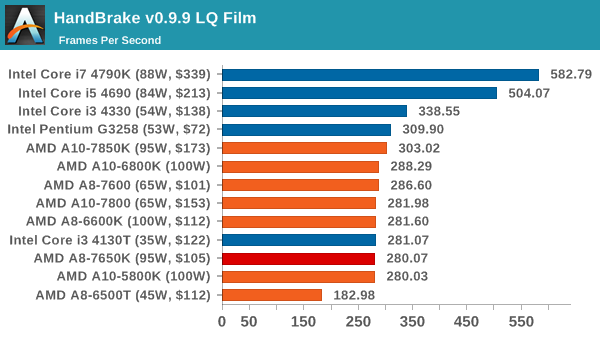
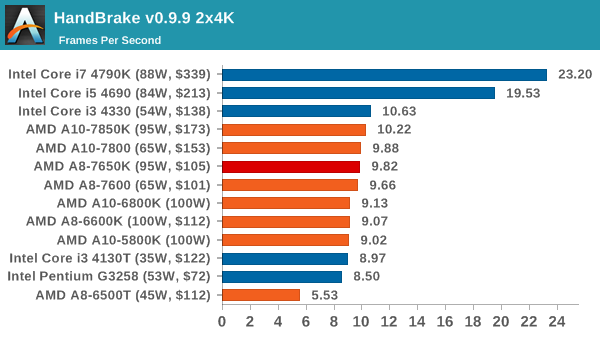
It's a similar story here, especially when we bring up 4K encoding in Handbrake. The APUs outperform the G3258 and the more expensive i3-T, but the i3-4330 is marginally quicker.
Hybrid x265
Hybrid is a new benchmark, where we take a 4K 1500 frame video and convert it into an x265 format without audio. Results are given in frames per second.
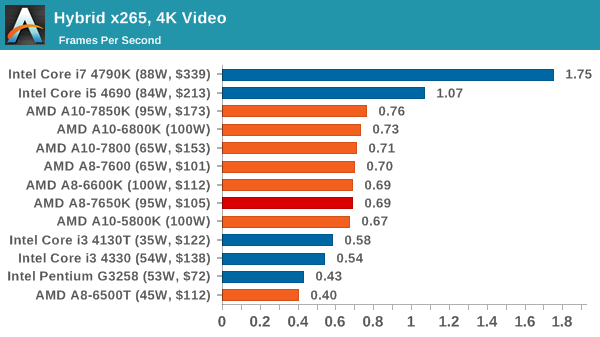










177 Comments
View All Comments
CPUGPUGURU - Tuesday, May 12, 2015 - link
AMD APU is a watt, money, time wasting bottlenecking inferior choice that there is next to no market for, for AMD fusion was and still is a delusion. Intel's world class IPC performance, node process and a dGPU are a MUCH BETTER investment.Intel's APU's performance advantage makes them a wise choice for the Tablet, Convertible, or Ultrabook market, I'm looking forward to a Surface Skylake to go mobile with.
mayankleoboy1 - Tuesday, May 12, 2015 - link
Ian, this is probably the 3rd or 4th testing methodology/benchmark changes that you have seen during AT. My question is:Do you think that Multithreading is *really* more mainstream now? As in, do most general purpose softwares use more than 2 cores?
Ian Cutress - Tuesday, May 12, 2015 - link
The way I like to think about it is that even if software only uses one core, I like to have many on the go at the time. Chrome tabs are a nice example.But multithreading is now being taught in some CS undergraduate classes, meaning that at least it's slowly entering the software ecosystem as default knowledge, rather than as an afterthought. In my opinion, that's always been a big barrier to multithreading (as well as having parallelizable code).
Another thought is consider the software you use. Is it made by a big multinational with a strong software development team? If yes, chances are it is multithreaded. If it uses a big commercial engine, it probably is as well. If it's based on a small software team, then it more likely isn't.
-Ian
V900 - Tuesday, May 12, 2015 - link
Multithreading being taught at CS classes today doesnt matter much.It's not like multithreading is some unknown new technology we can't take advantage of. Dual/quad core processors have been common for over a decade.
OS X have Grand Central Despatch. Windows 7/8 can take advantage of multithreading.
The problem is that it's not all tasks on a computer/in an operating system that does benefit from multithreading.
And that's not going to change. Otherwise we wouldn't see AMD going back to the drawing board and throwing the module-concept in the trash in order to focus on single thread performance like in the Zen CPU.
So unless you know you need it today, multithreading performance is a lousy parameter to choose a CPU from, cause it won't get better in the future.
ppi - Tuesday, May 12, 2015 - link
But now, how many real tasks, where CPU is the real bottleneck ...... and not GPU, storage, internet connection, or gasp ... the user ...
.. and such task is not multithreaded on reasonably written software?
Oxford Guy - Sunday, May 17, 2015 - link
According to rumor you mean.ToTTenTranz - Tuesday, May 12, 2015 - link
Why does Anandtech keep refusing to test lower performance CPUs and APUs with Mantle-enabled games?Those should be a great way to predict the advantages of lower CPU overhead in DX12 and Vulkan.
CPUGPUGURU - Tuesday, May 12, 2015 - link
BECAUSE Mantle is AMD ONLY and DX12/Vulkan will be Intel NVIDIA and AMD, THAT'S WHY.ALSO, Win10 DX12 HAS NOT Been released, drivers are beta at best, SO WHY waste time testing something that's beta and has NOT been released, WHY?
You AMD pumpoholics are brain dead and clueless.
V900 - Tuesday, May 12, 2015 - link
They also seriously think that "Mantle is basically DX12 +/- 10%" which is beyond deluded.Even after AMD knew that Mantle was a one way ticket to nowhere, and pretty much said as much, they still keep bringing it up and treat it as if it's not obsolete. Insanity...
ppi - Tuesday, May 12, 2015 - link
Mantle is currently a great way for to reduce CPU overhead for AMD APUs and CPUs.